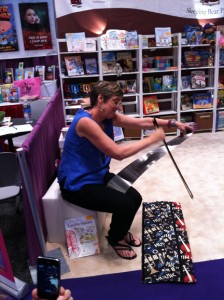I learned many things at BEA 2013, as I always do. I did not expect to get to hear Kate Sullivan (or anyone else for that matter) play the saw. It was amazing! And I got to try, too. Kate was very generous with her instruction. Kate has illustrated and written a gorgeous book called On Linden Square for Sleeping Bear Press. Gorgeous, fluid drawings, charming text–super. Go, Kate!
Part two of my notes as regards book promotion from the sessions I attended on Wednesday before the exhibition floor opened:
BEA Notes, Part 2
Talk #3
What’s Working Now: SEO, Author Platforms and New Social Media
Four Panelists:
Lori Culwell: bookpromotion.com, loriculwell.com
Katherine Sears: CMO at booktrope.com, co author of How to Market a Book
Lisa Hazen: Web Director at Chronicle, lisahazen.com
Britney Geragotelis: thebookslayer.com
Each of the panelists spoke one at a time, and then all chimed in answering Qs from the audience at the end.
Katherine:
- Step #1: Identify your target market: Who are they? How old? What do they do? What sex are they? Don’t sell to people not remotely in your market.
- On all social media (fb, twitter, pinterest, blog–ALL), employ the 3:1 ratio rule. Post three things about stuff related to your book to one post about your book or yourself.
- If you have trouble figuring out what to post, think about your reader and what they might want to know about. Three exercises to figure out what your reader is about are , 1. write down what you imagine is in your reader’s purse, 2. write a character study of your targeted reader, 3. go through your book and do a keyword grab. More on keywords later.
- If you HATE tweeting, the people reading your tweets will know this–don’t tweet. You must find social media venues that appeal to you, that you kind of “get.” But you must find them.
- She said that if your book is a women-related book, or a kids book (as mothers (more than fathers) buy books for kids), then Pinterest is a site that’s great as it is primarily women that use it. Facebook is primarily used by women and all adults ages 18-29.
Lisa:
- Use your author website as an extension of your own voice.
- You must have an author website
- Blog, but only if you can keep it up. If you can’t do one post a week, then don’t bother.
- Blog about lots of things, not just book related topics, as your readers want to know all about you.
- facebook and twitter are non-negotiable–you must do them (in her opinion)
- Integrated pics, posts, social media in one site: check out HappinessProject.com
- Make it easy to buy books by having easy links to vendors on your site
- Make it easy for you to be reviewed: Have a Press Room on your site where you have press releases, publicist contacts, and downloadable high-res images (an example of this is ReallyGoodMom.com who started with a website–the idea for their blog is they were “really good moms before they had kids”)
- Keep your website up to date
- Post once a week
- Short blocks of content work best
- Everything you do should circle back to your site–make it easy for people to find you.
Britney:
- After being rejected by agents and editors alike for 9 years, she began to offer chapters of her book Life’s a Witch (teen witches–or “twitches”) at Wattpad.com, an online book community of readers and writers. She soon had 16 million readers, and then a three book deal with Simon and Schuster.
- The social media things she does EVERY DAY: YouTube, facebook, Twitter, Wattpad, Pinterest, Instagram, Tumblr, and Blog (I know…I can’t imagine)
- She says that what she does online is as important as writing, in her mind. She has created this massive fan base, publishes supplements to books she has published, believes fervently in giving away free content. She gets about 5 million comments a month on all the various things she does.
Lori:
- Step 1. Google yourself. What’s there? If you do all the social media things like good authors, then the whole first page of the Google search will be stuff you are in control of (and not that unfortunate, but totally understandable police incident in Utah two summers ago)
- Step 2. Build a mailing list. Don’t forget–everyone starts at 0.
- Do keyword research using Market Samurai, Google, or Wordtracker.com. These places track what people actually search for. So if you are writing a gluten free cookbook, say, and type in “gluten free” into a keyword researcher, and the number one thing that people search for is “gluten free pancake recipe,” then not only should that be in your book, but might also be your first blog post.
- She also said find a social media thing that you really like to do and do that. She said to go to Knowem.com where you will find listed 500 different social media sites. Pick some, and try to have fun with it as this fun is translated to your audience.
- Don’t be afraid of giving things away.
- Use tracking software to see who visits your site: statpressvisitors, google analytics, and woopra (paid) are three to try.
- Be serious. You HAVE to do this to be successful.
Stay tuned for part 3, about facebook…

